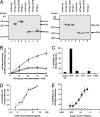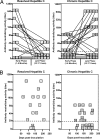Rapid induction of virus-neutralizing antibodies and viral clearance in a single-source outbreak of hepatitis C
- PMID: 17392433
- PMCID: PMC1851610
- DOI: 10.1073/pnas.0607026104
Rapid induction of virus-neutralizing antibodies and viral clearance in a single-source outbreak of hepatitis C
Abstract
In contrast to a detailed understanding of antiviral cellular immune responses, the impact of neutralizing antibodies for the resolution of acute hepatitis C is poorly defined. The analysis of neutralizing responses has been hampered by the fact that patient cohorts as well as hepatitis C virus (HCV) strains are usually heterogeneous, and that clinical data from acute-phase and long-term follow-up after infection are not readily available. Using an infectious retroviral HCV pseudoparticle model system, we studied a cohort of women accidentally exposed to the same HCV strain of known sequence. In this single-source outbreak of hepatitis C, viral clearance was associated with a rapid induction of neutralizing antibodies in the early phase of infection. Neutralizing antibodies decreased or disappeared after recovery from HCV infection. In contrast, chronic HCV infection was characterized by absent or low-titer neutralizing antibodies in the early phase of infection and the persistence of infection despite the induction of cross-neutralizing antibodies in the late phase of infection. These data suggest that rapid induction of neutralizing antibodies during the early phase of infection may contribute to control of HCV infection. This finding may have important implications for understanding the pathogenesis of HCV infection and for the development of novel preventive and therapeutic antiviral strategies.
Conflict of interest statement
The authors declare no conflict of interest.
Figures



References
Publication types
MeSH terms
Substances
Grants and funding
LinkOut - more resources
Full Text Sources
Other Literature Sources
Medical

